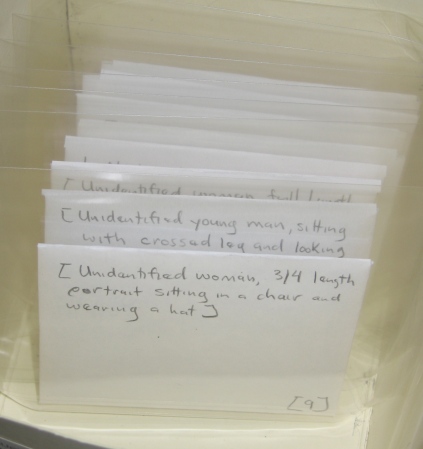Written by James DaMico, Graphics Project Archivist
One of the tasks of the archivist is to ensure that collections are stable enough for a researcher to handle. This task is called preservation. The American Institute for Conservation (AIC) defines preservation as “The protection of cultural property through activities that minimize chemical and physical deterioration and damage and that prevent loss of informational content. The primary goal of preservation is to prolong the existence of cultural property.”[a]
Examples of this task range from placing material in Mylar sleeves, four flap enclosures, archival mats or creating copy photographs or microfilm of the original that has been deemed too fragile to handle. All of the above mentioned methods provide and protect the original item and surrounding items from further damage.
All material such as newspapers, photographs, architectural drawings and magnetic media suffers from inherent vice which is a term used to describe the internal instability of an item that is “introduced during its manufacture” [b]. This instability leads to both mechanical and chemical failure. Other factors that contribute to the degradation of cultural property are poor handling, improper storage material, uncontrolled temperature and humidity, pests, pollutants both external and internal and theft.
For example, newspapers are composed of highly acidic wood pulp which turns brittle and yellow in a short span of time. Flexible photographic negatives were first manufactured using cellulose nitrate plastic and then cellulose acetate plastic, also known as safety film. The former, particularly in motion picture film, is highly volatile and once it begins to deteriorate, loss of image becomes greater at an increased rate. For more information see: http://cool.conservation-us.org/byauth/messier/negrmcc.html
Top view of the [Bennett family (?) photo album]
This is a photo album comprised of family portraits in the tintype and carte de visite photograph formats. A Tintype is a direct photograph that uses the wet collodion negative process on a sheet of lacquered iron. Tintypes were inexpensive to produce and purchase and were generally found in photo albums or paper window mats and were popular from about 1860-1890. Carte de visite photographs or visiting cards are albumen positives that are mounted on card and measure 4.75 x 2.5 inches. The carte de visite was also an inexpensive photograph to produce and purchase and were popular from about 1860-1880.
View of how the album pages had become detached from the spine. The covers of this album have separated from the spine and the lining is exposed. The pages are very acidic and brittle. The original binding had become brittle resulting in the pages separating from the spine. Notice also how the tintype has become loose from the window mat. If left in this state, the tintypes would have become further damaged.
A decision was made by the Graphics Project Archivist to first assign an artificial page numbering system for the album. The pages numbers are indicated as such [x].
This ensures that the original order of the images is retained. The endangered tintypes were placed in four flap enclosures with the page number and a brief description of the image on the front. Four flap enclosures allow a researcher to easily view an image without causing further damage. The enclosed tintype was then placed in a 4 x 5 inch Mylar sleeve for easy access.
All original pages have been retained as some of them have identifying information on them. The pages have been placed in acid free folders in groups of 10. When a page was intact with no loose tintypes, the entire page was placed in a 5 x 7 inch four flap enclosure and then into a 5 x 7 inch thumb cut envelope.
This is an example of two pages that were still bound together although very poorly. The photographs have remained in the window mats. The pages were individually placed in acid free 5 x 7 inch four flap enclosures.
[a] AIC Definitions of Conservation Terminology. http://cool.conservation-us.org/waac/wn/wn18/wn18-2/wn18-202.html (accessed 2011_05_03)
[b] Lesson 1: What is paper preservation? http://www.ncptt.org/pdf/1999-30.pdf (accessed 2011_05_03)
Recommended reading:
Preserving Your Collection of Film-Based Photographic Negatives
http://palimpsest.stanford.edu/byauth/messier/negrmcc.html
National Park Service – Museum Management Program
http://www.nps.gov/history/museum/publications/MHI/mushbkI.html
AIC Definitions of Conservation Terminology
http://cool.conservation-us.org/waac/wn/wn18/wn18-2/wn18-202.html
Van Der Reyden, Dianne. “The Science-Based Fight Against Inherent Vice.” International Preservation News 50 (2010): 5-10. International Federation of Library Associations and Institutions (IFLA) Core Activity on Preservation and Conservation (PAC). Web. (accessed 2011_05_03) (http://www.ifla.org/files/pac/ipn/50-may-2010.pdf#page=5).









 Posted by 2010rihsgraphics
Posted by 2010rihsgraphics